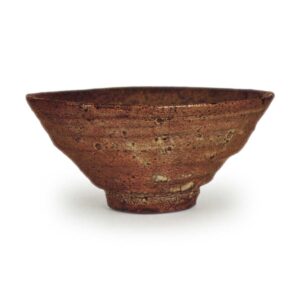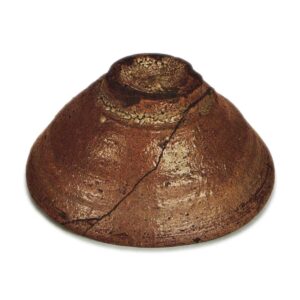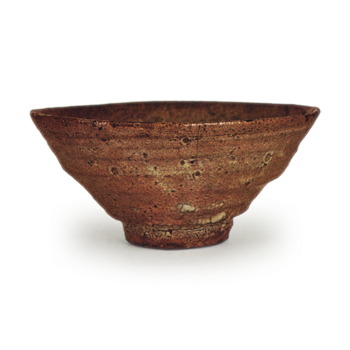

Held at: Hatakeyama Memorial Museum
Height: 6.4-6.8cm
Diameter: 14.0-14.5cm
Height of foot ring: 4.8-5.0cm
Height of body: 0.9-1.0cm
The name of the Tanaka well comes from the fact that it was once owned by Tanakajirozaemon, a member of the Tanakaya family, a prominent family in Isezu, and it was first unveiled at the Daishikai tea ceremony held at Sankeien in Yokohama in 1922. After that, it was not known, but in May 1958, it was again unveiled at a tea ceremony (Tokyo seat) of the Five Metropolitan Union Art Youth Association held at Koetsuji in Takagamine, Kyoto, and it suddenly became famous as it gained the praise of tea ceremony enthusiasts.
All of the Aoido teapots that are considered to be excellent are small, well-made, and feature a strong, tight-knit texture, and the Tanakaido teapot also meets these criteria. In fact, it is not at all inferior to the famous Aoido teapots.
First, looking at the workmanship, the four-stage rough turning of the wheel is particularly strong and firm, and the body is especially firm and resolute. The foot ring is carved sharply in one go, and the bamboo-jointed foot ring tapers to the shape of a bucket bottom, with the rhythm of the undulations on the outside showing a wonderful sense of change, and being pleasant to the eye and to the touch. Compared to the world-famous Shibata Hōju-an, it is difficult to say which is better. When I first saw this tea bowl at the tea ceremony at Kōetsu-ji in Takanomine in late autumn many years ago, I was struck by its flawless workmanship. If the characteristic of the Aoido tea bowls is their small size, yet their dignified, sharp, and agile appearance, then this Tanaka tea bowl has all of these qualities. The tightness of the foot ring is also an important feature of the famous Shibata ware bowls, and it brings out the characteristics of the ware even more. In the center of the foot ring, the sharp peak of the helmet-shaped rim also has the effect of accentuating the dots, as is the case with all well bowls.
The glaze shows a loquat-colored sheen on the surface of the clay, which shows the fine lines of the nuta-hiki (a technique in which the clay is pulled into fine lines). As the name suggests, Aoido is usually a bluish-green glaze, but this is due to the clay, which has more iron than Oido, and the kiln firing habits, etc., and the glaze, which has a bluish-green tinge, gives the viewer the impression of being dull and damp. The work is also generally thick and dull. In relation to this, there are cases where pieces that have been glazed a bluish color by the hands of the Ko-Karatsu potters are sometimes referred to as Aoido. However, the Aoido clay has more iron than Karatsu clay, and the glaze is softer and less glossy.
It is also lighter than Karatsu.
A good example of a Biwa-iro-agari is the Shibata-ido, but the softness of the glaze is different from that of the Oido. In general, the softness of the clay and glaze is a characteristic of Aoido, and in that respect, it is not possible to generalize about Biwa-iro-agari.
There is a beautiful kaaragi pattern from the foot to the inside of the foot ring, and together with the white glaze pool on the body, it is a highlight of the piece. There are five foot rings on the tatami mat. There are places on the inside of the body where the strong wheel marks from the outside have been stretched, and there are three marks on the inside and a long horizontal crack in the tea pool. There is a large crack running along the side of the foot ring, and the fact that the rim has been repaired at both ends is a shame, but the workmanship, the glaze, and the other points of interest mentioned above more than make up for this.
It is certainly not an exaggeration to call it the finest piece in the Aoido collection.
It was passed down from the Tanaka family to the Osaka Tanimatsuya Toda Yashichi, and then to the Tokyo Umakoshi family, but it is now in the collection of the Hatakeyama Memorial Museum.



